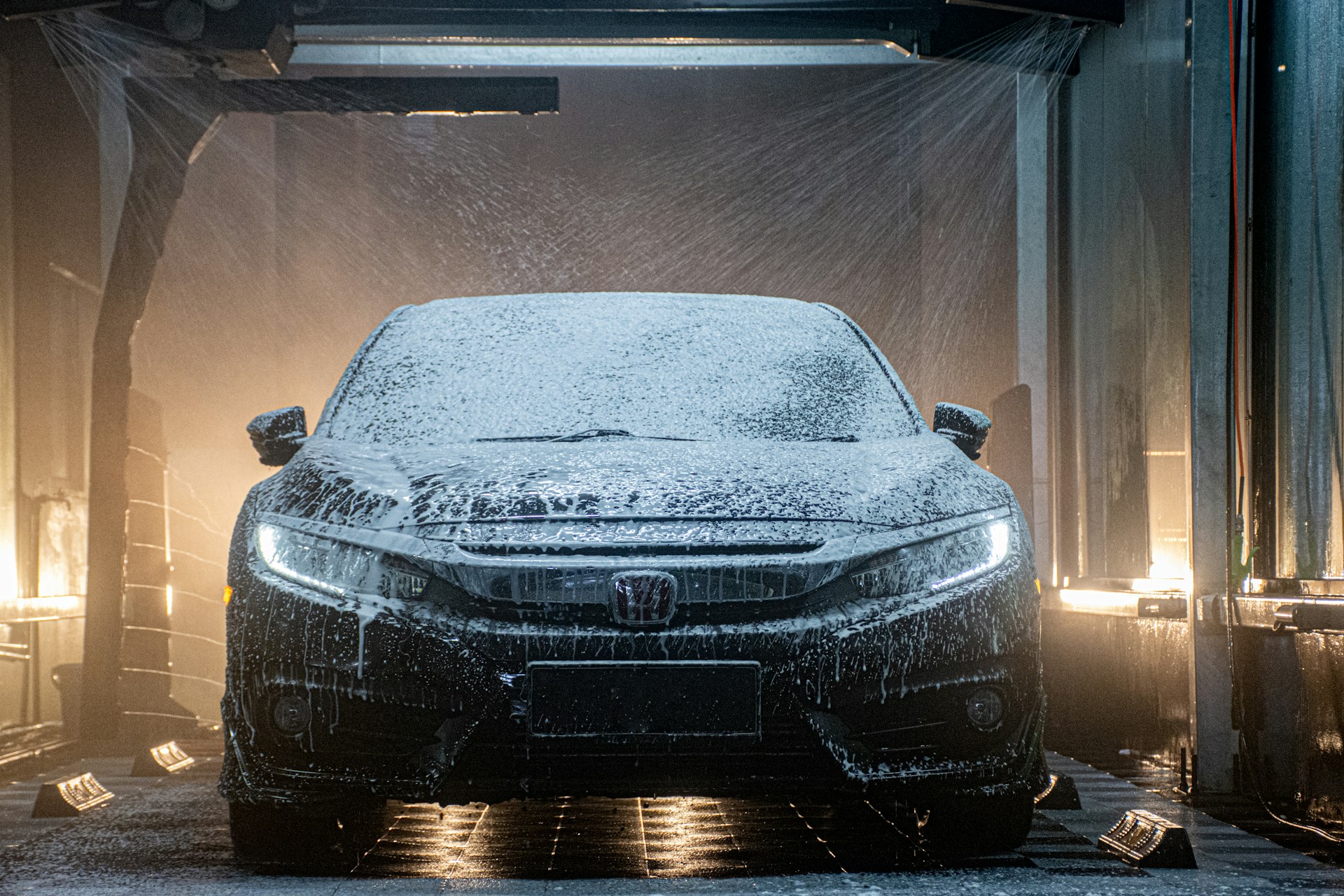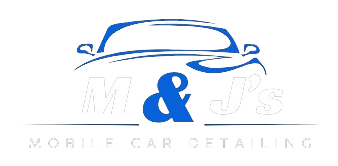
Automatic car washes are fast, convenient, and available almost everywhere. With a quick drive-through, your car comes out looking cleaner than it did when it went in. For many people, they’re the easiest way to keep a car clean.
The short answer is that some automatic car washes can damage your paint, while others are safer depending on the system, equipment, and wash method. Understanding the differences between types of car washes, how paint becomes damaged, and how to protect your vehicle can help you make the right decision for your car.
We will explain everything you need to know about automatic car washes—how they work, what risks they pose, and what options are safest for your vehicle.
Why People Worry About Automatic Car Washes
Modern vehicles have delicate clear coats that are easily scratched by dirt, rough materials, and harsh chemicals. Many older automatic washes use stiff rotating brushes or dirty cloth strips that drag contaminants across the paint. Over time, this can lead to swirl marks, fading, oxidation, and a dull finish.
Even newer touchless washes have their own drawbacks, such as strong chemicals that can strip wax or shorten the life of coatings. Because of these issues, many detailers recommend hand-washing your car—either yourself or through a professional service.
But automatic car washes aren’t all equally risky. Some are fairly gentle, while others can cause noticeable damage after only a few visits. Knowing the difference can save your paint.
The Different Types of Automatic Car Washes
Not all automatic washes are the same. There are three main types, and each one affects your car differently.
1. Brush-Style Automatic Car Washes (Worst for Paint)
These are the traditional drive-through car washes where spinning brushes slap against the vehicle. The brushes often hold dirt, sand, and debris from previous cars. When those brushes hit your paint, they drag that debris across the surface, causing micro-scratches, swirl marks, and dulling over time.
These systems are also rough on mirrors, wipers, trim pieces, and antennas. In many cases, the brushes are old, worn out, or poorly maintained, making the risk of damage even higher.
2. Soft-Cloth Car Washes (Still Risky)
Soft-cloth washes replaced older bristle brushes with large strips of synthetic cloth. While gentler than stiff brushes, the cloth still absorbs dirt and grime from every car before yours. This trapped debris can leave micro-scratches or swirl marks, especially on dark-colored vehicles.
Many drivers prefer these because they’re quieter and seem softer, but the risk is still there if the wash isn’t properly maintained or cleaned regularly.
3. Touchless Automatic Car Washes (Safer but Not Perfect)
Touchless washes rely on water pressure and chemicals to clean your vehicle instead of brushes or cloth strips. Since nothing touches your paint, the risk of physical scratching is much lower.
However, because the system doesn’t scrub the surface, it uses strong detergents that can strip wax, sealants, and even shorten the life of ceramic coatings.
Touchless washes are a safer option for your paint overall, but you’ll need to reapply protection more often.
How Automatic Car Washes Damage Your Paint
The biggest cause of damage from automatic washes is friction combined with dirt and grime. Anytime something dirty rubs against your car, it acts like sandpaper.
Damage usually appears as:
Swirl marks — circular scratches visible in the sun Micro-scratches — fine lines that dull the surface Clear-coat abrasion — long-term dulling or fading Water spots — from recycled or untreated water Trim wear — discoloration or fading Metal scratches — from old or damaged equipment
Some washes also use recycled water that may contain impurities or chemicals that can leave mineral deposits and spotting.
What About the Undercarriage?
Many automatic washes include an undercarriage spray to remove salt, dirt, or debris. In snowy or coastal areas, this can help slow down rust. However, some older wash systems use high pressure that can force water into dents, gaps, or electrical areas.
For most cars, modern undercarriage sprays are safe and helpful, but they should not replace regular hand-cleaning or detailing.
Are Touchless Car Washes Safe?
Touchless washes are generally the safest automatic option because nothing physically touches the paint. But they often use extremely strong chemicals to break down dirt, which can wear away protective layers.
If you rely on touchless washes, you should maintain your paint protection regularly. A good hydrophobic spray helps replenish protection after each wash:
-
Turtle Wax Hybrid Solutions Spray Coating: https://www.amazon.com/dp/B07VNBYFQ1
-
Griot’s Garage Ceramic 3-in-1: https://www.amazon.com/dp/B07PT8W5L2
These restore slickness and shine after harsh soaps.
Are Automatic Car Washes Bad for Ceramic Coatings?
It depends on the type:
Brush washes can severely scratch the coating and shorten its lifespan. Soft-cloth washes can wear down the coating over time. Touchless washes are safe but may weaken the coating’s hydrophobic performance due to strong chemicals.
Most professional detailers recommend hand-washing coated vehicles, but touchless washes are acceptable for quick maintenance when needed.
Are Automatic Car Washes Bad for Wraps or PPF?
Vinyl wraps and paint protection film (PPF) are more sensitive than paint.
Brush washes can damage wraps by tearing edges or scratching the material. Soft-cloth washes can pull up seams or edges. Touchless washes are generally safe but may reduce gloss over time.
For wraps, always check the manufacturer guidelines. Companies like 3M and Avery generally recommend hand washing or touchless only.
Pros and Cons of Automatic Car Washes
Automatic washes have benefits, but the risks often outweigh the convenience—especially for people who want to protect their paint long-term.
Pros
Fast and convenient Affordable Widely available Can remove basic dirt and debris Works when hand washing isn’t possible Good for winter or bad weather cleaning Touchless washes reduce physical damage risks
Cons
Brushes trap dirt that scratches paint Strong chemicals can strip protection Some washes use contaminated recycled water High-pressure systems can damage fragile trim Not ideal for ceramic coatings, wraps, or PPF Can dull the paint over time
The Safest Way to Wash Your Car
The safest option is always a proper hand wash using high-quality tools and products. A two-bucket wash method dramatically reduces the risk of scratching the paint.
Recommended items for scratch-free washing:
-
Chemical Guys Mr. Pink Car Wash Soap: https://www.amazon.com/dp/B00BQYCKE8
-
Grit Guard Bucket Insert: https://www.amazon.com/dp/B0009IEJ0G
-
Chenille Wash Mitt: https://www.amazon.com/dp/B01N1O8A8K
These help remove dirt safely without dragging it across the paint.
How to Protect Your Paint If You Use Automatic Car Washes
If you rely on automatic washes, you can still protect your vehicle by taking a few precautions:
Choose touchless washes whenever possible. Avoid brush/cloth washes completely. Apply a ceramic spray coating regularly. Keep your vehicle waxed or sealed. Avoid washing in direct sunlight. Dry the car after a wash to prevent water spots.
A good drying towel helps prevent streaks and reduces the chance of scratches:
-
The Gauntlet Drying Towel by The Rag Company: https://www.amazon.com/dp/B07KXGGW8G
Frequently Asked Questions About Automatic Car Washes
Do automatic car washes cause swirl marks?
Yes. Brush and cloth-style washes often cause swirl marks because they drag dirt across the paint.
Are touchless car washes completely safe?
They are safer because nothing touches the paint, but the chemicals can weaken waxes or coatings.
Can automatic washes damage trim or mirrors?
Old brushes, loose equipment, and high pressure can damage plastic trim, antennas, or mirrors.
How often is it safe to use an automatic car wash?
Using a touchless wash occasionally is fine, but frequent use of brush-style washes can quickly dull and scratch your paint.
Do automatic car washes reuse water?
Many do. Recycled water may hold dirt or minerals that cause spotting or dullness.
Can ceramic coatings help protect my car in automatic washes?
Yes. Ceramic coatings add a hard protective layer, but they can still wear down faster with frequent automatic washing.
Automatic Car Washes are Convenient, Fast, and Useful
Automatic car washes are convenient, fast, and useful when you don’t have time to hand wash your car. However, not all automatic washes are safe. Brush and soft-cloth washes can scratch your paint, dull your finish, and damage trim. Touchless washes are a safer option, but their chemicals can strip protective layers.
For the best results and the longest-lasting shine, hand washing will always give you the safest clean. If you must use an automatic car wash, choose a touchless system and keep your paint protected with ceramic sprays or sealants.
With the right care, washing methods, and protection, you can keep your vehicle looking new while avoiding damage—even if you occasionally rely on automatic washes.

